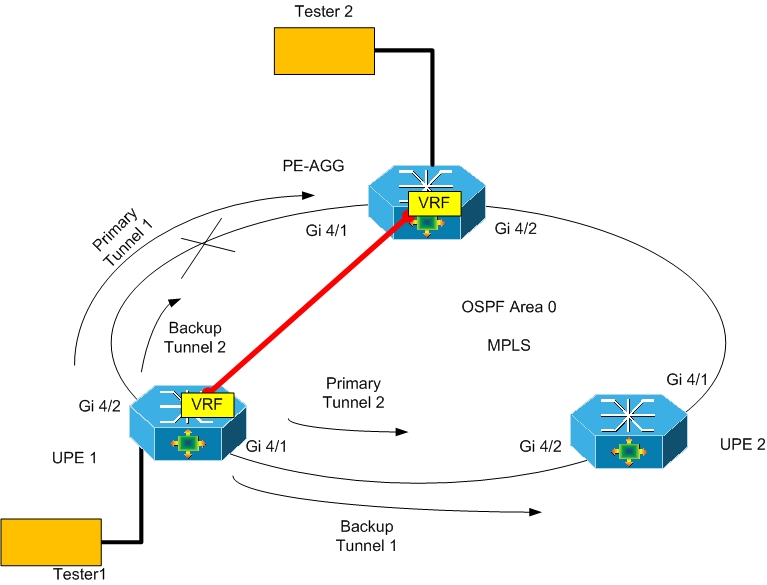- Cisco Community
- Technology and Support
- Service Providers
- MPLS
- MPLS TE-FRR cannot recovery in less than 50mms
- Subscribe to RSS Feed
- Mark Topic as New
- Mark Topic as Read
- Float this Topic for Current User
- Bookmark
- Subscribe
- Mute
- Printer Friendly Page
MPLS TE-FRR cannot recovery in less than 50mms
- Mark as New
- Bookmark
- Subscribe
- Mute
- Subscribe to RSS Feed
- Permalink
- Report Inappropriate Content
09-29-2011 12:34 AM
Dear all,
Our topology have three 6504 box connect to each other as a Ring like the topology below:

All Switch are running IOS:
s72033-advipservicesk9_wan-mz.122-18.SXF6.bin
The routing protocol is OSPF with MPLS. I have config on all link TE-FRR with RSVP and make sure all Tunnel are UP and the TE-FRR is running well.
I test the recovery time of network by the way config MPLS Layer 3 VPN between UPE 1 and PE-AGG, start the traffic from Tester 1 to Tester 2. And then I suddenly shutdown the link between UPE and PE-AGG. The link is down immediately, but I saw on the tester the recovery time is 300mms (without the TE-FRR is 700mms). With the TE-FRR, the receovery is more smaller but its doesnt meet the requirement < 50mms.
When we test the same strategy on another Ring, running ISIS and MPLS TE-FRR with Cisco 7600 and IOS SRE. The recovery time when down link is only 13-20 ms, it's quite a good result.
I make sure all the TE-FRR configuration are valid and the traffic running via interface Tunnel. After I shut the primary link, traffic auto direct via backup tunnel interface.
Please help me troubleshooting this problem!
Thank you so much,
Manh Nguyen
- Labels:
-
MPLS
- Mark as New
- Bookmark
- Subscribe
- Mute
- Subscribe to RSS Feed
- Permalink
- Report Inappropriate Content
09-30-2011 01:53 AM
Hi Manh
Can you please provide more details on the two different Network Setups:
1. SETUP-1 ACESS RING with IGP OSPF on c6500
2. SETUP-2 ACCESS RING with IGP ISIS on c7600
a) Are you using any IGP Tuning for Fast-Convergence in both the cases or not. If Yes , then is that implemented similarly on both the setups.
In my personal opinion as I think the issue seems to be related to the difference in the IGP Fast-Convergence between the two setups ( detecting the failure, propogating and refreshing the LSAs,SPF Trigger ) or possibly due to H/W Limitations ( I doubt on this personally much) between the two setups.
Hope this gives you some pointers in your troubleshooting approach. Please let know the answers for above queries so more detailed analysis can be taken forward and understand the problem.
Thanks & Regards
Vaibhava Varma
- Mark as New
- Bookmark
- Subscribe
- Mute
- Subscribe to RSS Feed
- Permalink
- Report Inappropriate Content
10-03-2011 08:59 PM
Hi Vaibhava
The 2 network setups has the same topology and same test strategy:
1. SETUP-1 ACCESS RING with IGP OSPF on c6500:
- IGP OSPF on 1 area.
- MPLS LDP, TE-FRR link protection
- IOS:s72033-advipservicesk9_wan-mz.122-18.SXF6.bin
- Cisco Catalyst 6504
- Linecard WS 6704
2. SETUP-2 ACCESS RING with IGP ISIS on 7600:
- IGP ISIS 1 area
- MPLS LDP, TE-FRR link protection
- IOS:c7600rsp72043-advipservicesk9-mz.122-33.SRE3.bin
- Cisco 7600
- Linecard ES+
I dont use any IGP Tuning method on both 2 setups. I sent to your PM inbox the configuration log of the SETUP-1. Please help me take a look at it.
Thank you so much for your help!
Best Regards,
Manh Nguyen
- Mark as New
- Bookmark
- Subscribe
- Mute
- Subscribe to RSS Feed
- Permalink
- Report Inappropriate Content
10-03-2011 09:22 PM
Hi Manh
Thanks for providing the details of your setup.
So as it seems both setups are the same but still Setup 2 is achieveing the sub-50 ms convergence but Setup 1 can not.
I have yet not received your configs in PM inbox so if you can send it again to me and I will run through it once.
Regards
Varma
- Mark as New
- Bookmark
- Subscribe
- Mute
- Subscribe to RSS Feed
- Permalink
- Report Inappropriate Content
10-02-2011 09:45 AM
Yesterday, I was also working with same kind of ring topology but did not get the failover time equals to 50ms. I configured BFD rather than MPLS-TE.
But after tweaking IGP parameters LSA paccing and throttling, I was able to acheive that.
If you see by default OSPF takes 2 - 3 seconds to converge and LSA is updated in 5 seconds which acually restrict the tpology to come up fast.
regards
Shivlu Jain
Discover and save your favorite ideas. Come back to expert answers, step-by-step guides, recent topics, and more.
New here? Get started with these tips. How to use Community New member guide